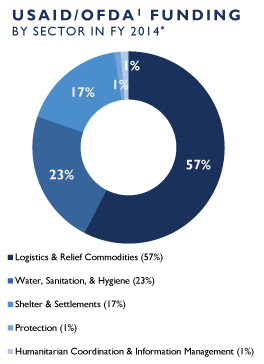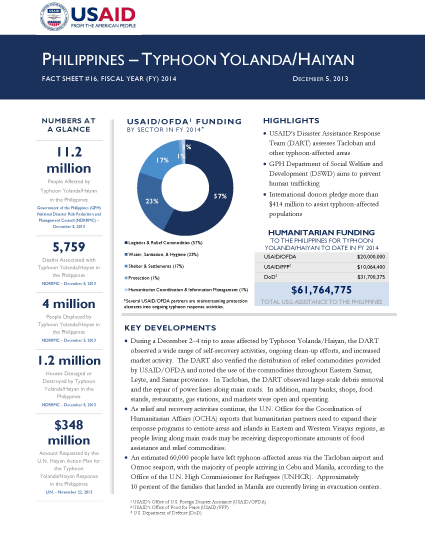- What We Do
- Agriculture and Food Security
- Democracy, Human Rights and Governance
- Economic Growth and Trade
- Education
- Ending Extreme Poverty
- Environment and Global Climate Change
- Gender Equality and Women's Empowerment
- Global Health
- Water and Sanitation
- Working in Crises and Conflict
- Disaster Assistance
- Political Transition Initiatives
- Conflict Mitigation and Prevention
- Countering Violent Extremism
- Disaster Risk Reduction
- Peacebuilding and Reconciliation
- Providing Safe & Secure Environments for Development
- Recovering From Crisis
- Resilience
- Tech Challenge for Atrocity Prevention
- World Humanitarian Day
- U.S. Global Development Lab
December 5, 2013
Numbers At A Glance
11.2 million
5,759
4 million
1.2 million
$348 million
Humanitarian Funding:
To The Philippines For Typhoon Haiyan/Yolanda To Date In FY2014:

| USAID/OFDA | $20,000,000 |
| USAID/FFP | $10,064,400 |
| DoD | $31,700,375 |
| TOTAL | $61,764,775 |
Typhoon Haiyan / Yolanda Fact Sheet #16 - 12/05/2013 ![]() (pdf - 235k)
(pdf - 235k)
Highlights
USAID's Disaster Assistance Response Team (DART) assesses Tacloban and other typhoon-affected areas.
GPH Department of Social Welfare and Development (DSWD) aims to prevent human trafficking.
International donors pledge more than $414 million to assist typhoon-affected populations.
Key Developments
During a December 2–4 trip to areas affected by Typhoon Yolanda/Haiyan, the DART observed a wide range of self-recovery activities, ongoing clean-up efforts, and increased market activity. The DART also verified the distribution of relief commodities provided by USAID/OFDA and noted the use of the commodities throughout Eastern Samar, Leyte, and Samar provinces. In Tacloban, the DART observed large-scale debris removal and the repair of power lines along main roads. In addition, many banks, shops, food stands, restaurants, gas stations, and markets were open and operating.
As relief and recovery activities continue, the U.N. Office for the Coordination of Humanitarian Affairs (OCHA) reports that humanitarian partners need to expand their response programs to remote areas and islands in Eastern and Western Visayas regions, as people living along main roads may be receiving disproportionate amounts of food assistance and relief commodities.
An estimated 60,000 people have left typhoon-affected areas via the Tacloban airport and Ormoc seaport, with the majority of people arriving in Cebu and Manila, according to the Office of the U.N. High Commissioner for Refugees (UNHCR). Approximately 10 percent of the families that landed in Manila are currently living in evacuation centers.
HEALTH AND WASH
- The GPH-led Strategic Advisory Group, operating under the leadership of the GPH Department of Health, is finalizing its Strategic Operational Framework for water, sanitation, and hygiene (WASH) activities based on partner input. The overall goal of the framework is to reduce public health risks by ensuring that mortality and morbidity levels are brought to pre-typhoon levels by improving access to safe drinking water, providing adequate access to sanitation, and promoting good hygiene practices.
- On December 3 and 4, the DART visited five evacuation centers in Tacloban, including two of the largest centers and one in the process of closing. The DART WASH advisor reports that the majority of households had access to safe drinking water, due to adequate bottled water resources and public water supply. Latrines were clean and households reported being satisfied with the available facilities; however, the number of latrines was often below the Sphere minimum standards. Households also reported receiving soap and point-of-use water treatment supplies and had been able to purchase additional hygiene products locally.
- To date, USAID/OFDA partner the U.N. Children’s Fund (UNICEF) has provided water kits, water treatment products, and water bladders to more than 360,000 people in affected areas. In addition, UNICEF has provided hygiene-related relief items to approximately 100,000 people and established temporary latrines benefiting approximately 25,000 people.
- The GPH-led immunization campaign continues to support measles and polio vaccinations for children under five years of age in affected areas with the support of the U.N. World Health Organization and other partners, including UNICEF.
- To date, UNICEF has procured $3.4 million in supplies—including generators and solar-powered freezers—for vaccine supply chain restoration to support the GPH-led campaign in Cebu, Eastern Samar, and Leyte and Roxas city, Capiz Province. USAID/OFDA has provided nearly $720,000 to support UNICEF’s WASH activities in affected areas, including the installation of gender-sensitive and child-friendly latrines and bathing spaces in evacuation centers and the distribution of hygiene materials, such as soap and buckets, in schools and other community spaces.
PROTECTION
- The International Organization for Migration (IOM) reports that its Displacement Tracking Matrix (DTM) has completed coverage in Eastern Visayas Region. The DTM currently covers approximately 41,000 people throughout 143 municipalities in Leyte and Eastern Samar provinces, including Ormoc and Tacloban cities and Guiuan municipality, as well as three municipalities in Roxas. Migration Outflow Desks in Guiuan and Ormoc continue to track population movements at ports, bus terminals, and airports.
- UNICEF has conducted training on Rapid Family Tracing and Reunification for local government officials and staff at women and children protection desks, which are located in police precincts and assist with issues related to the abuse of women and children, in Leyte and Eastern Samar provinces.
- DSWD is partnering with the GPH Department of Labor and Employment (DOLE) and the Inter-Agency Council Against Trafficking (IACAT) to conduct an information campaign to educate internally displaced persons arriving in Manila on their rights and responsibilities, and how to detect an illegal recruiter or trafficker. DSWD warns that illegal recruiters may seek to take advantage of typhoon-affected populations in need of financial assistance, as well as unaccompanied minors. DOLE and IACAT have established hotlines, as well as a booth at Villamor Airbase in Manila, a main point of entry to the city for typhoon-affected people, to accommodate inquiries and reports on possible trafficking and illegal recruitment activities involving typhoon-affected populations.
FOOD SECURITY
- As of December 4, USAID/FFP implementing partner the U.N. World Food Program (WFP) had dispatched 4,340 metric tons (MT) of rice, more than 150 MT of high-energy biscuits, and 1.2 MT of Plumpy’Doz, a ready-to-use supplementary food product, for approximately 3 million people. On December 3, WFP dispatched a shipment of 7,000 MT of rice, which will be distributed to more than 150,000 households in Samar and Leyte islands through two rounds of 15-day rations during December.
- Initial results from assessments conducted in northeastern Leyte Province indicate that markets and traders are beginning to recover and basic foods are now available, according to WFP. However, access to markets remains difficult for vulnerable populations, particularly elderly and disabled people.
NUTRITION
- As of December 5, partners of the Nutrition Cluster—the coordinating body for nutrition activities in the Philippines—had screened approximately 21,000 children for acute malnutrition, with 172 children identified as suffering from severe acute malnutrition and 531 showing signs of moderate acute malnutrition. Prior to the typhoon making landfall, chronic malnourishment was prevalent in some affected areas, including Tacloban and Cebu, with an estimated one-third of children under the age of five chronically malnourished, according to the 2011 National Nutrition Survey.
- UNICEF is distributing multiple micronutrient powder to 45,000 children between six months and two years of age in evacuation centers in Tacloban, Cebu, and Roxas. The powder, which can be added to food just before it is eaten, will sustain the micronutrient levels of beneficiary children over the next three months.
- UNICEF and Nutrition Cluster partners have established 15 parent- and baby-friendly tents in Guiuan. Each tent is equipped with early childhood development kits, which provide infant and young child feeding messages for mothers and caretakers during malnutrition screenings.
LOGISTICS AND RELIEF COMMODITIES
- To date, the Logistics Cluster has transported approximately 3,500 MT of relief commodities via road and sea routes. Additionally, the U.N. Humanitarian Air Service (UNHAS) has transported more than 650 humanitarian personnel and 6 MT of relief commodities to 15 locations since UNHAS operations began in the Philippines on November 17.
- The process of identifying warehouses for rehabilitation to support long-term storage capacity in Tacloban is underway, according to the Logistics Cluster. Partners plan to repair a gymnasium and a warehouse near the Tacloban port and are currently preparing a cost estimate for the operation. The cluster continues to procure and assemble mobile storage units to support the relief operations of humanitarian organizations, including the International Federation of Red Cross and Red Crescent Societies (IFRC), Médecins Sans Frontières, and USAID/OFDA partner Oxfam.
- As of December 4, the Logistics Cluster had facilitated the dispatch of 13.3 MT of relief commodities—including medical supplies, education and WASH kits, and plastic sheeting—from Cebu to affected areas with the support of military aircraft from Australia and Sweden.
- WFP is contracting 40 trucks in Tacloban to facilitate the delivery of food assistance and assist DSWD with relief commodity distributions to affected areas. Other humanitarian partners, such as UNHCR, plan to use the WFP-contracted trucks to transport relief cargo from the Tacloban airport to storage facilities.
INTERNATIONAL ASSISTANCE
- In response to a request from the GPH, the Government of Japan has dispatched a Japan Disaster Relief Expert Team to the Philippines due to the large oil spill off the coast of Panay Island, Iloilo Province, which resulted from typhoon-related damage to a barge and displaced approximately 1,200 people. The team primarily comprises members of the Japan Coast Guard and will provide advice to the GPH on oil removal and control.
- As of December 4, donor pledges, cash, and in-kind assistance, had covered nearly 40 percent of the $80 million emergency appeal for Typhoon Yolanda/Haiyan launched on November 12 by IFRC to assist 100,000 households—or approximately 500,000 people—within 18 months. On December 4, IFRC called for additional donations to enable the Philippine Red Cross to meet the needs of affected households.
- As of December 5, international donors had pledged more than $414 million to address the needs of populations affected by Typhoon Yolanda/Haiyan. The total amount pledged exceeds the $348 million requested by the revised U.N. Haiyan Action Plan for the Philippines typhoon response.









Comment
Make a general inquiry or suggest an improvement.